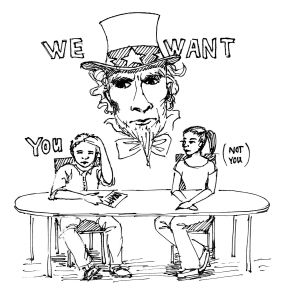Many seniors have already come of age or are nearing their 18th birthday, an exciting yet nerve wracking transition. It can be daunting to approach adulthood with new civic responsibilities that are relevant not only to an adult individual, but also to a citizen with a duty to serve the country.
In 2015, the United States still enforces mandatory registration for military conscription, the forced enlistment into the armed services, commonly referred to as a draft—and it continues to exclude women from its call to service.
Since the first conscription legislation was passed in 1917 in response to slow enlistment during World War I, the selective service system has only applied to men. Almost 100 years later, not much about the act has changed––it still discriminates against women, whether the nation is in wartime or peacetime.

The last use of the draft ended in 1973, 42 years ago. Since then the way the world functions has dramatically shifted, as have the social conditions for gender. Naturally with the passing of time, the weapons and strategies that we use to fight have dramatically changed as well. However, the laws regarding conscription and the gender requirements for roles within the military have not progressed along with the times.
If a woman tried to register for the draft online today, she would be redirected to a webpage explaining that females are not required to serve their country in a time of necessity, however, the initial page for draft registration states, “It’s your duty as an American, and it’s the law.” But if it is the duty of an American citizen then why are women excluded? The fact that women are still disbarred from this national responsibility that should be shared by all citizens sends a negative message to the population. The policy suggests that women cannot be depended upon to contribute to the safety of the country when it needs to be prepared to take militarily action.
Not only is the exclusion of women from conscription discriminatory and outdated, it is also unfair to the male population to have to carry the entire burden. If the responsibility were shared by both genders, the encumbrance would be less significant.
Women are more than capable of military participation, which has been proven by many strong individuals, such as Deborah Sampson, a woman who disguised herself as a man to fight with the continental army in the Revolutionary War, or Sarah Rosetta Wakeman, a woman who also used a male alias to fight for the Union in the Civil War.
However, despite numerous displays of leadership, capability, and devotion, as of 2014, only 78 percent of military roles are available to women, notably excluding the roles of Army Ranger and Navy SEAL. This statistic is accurate even after a significant restriction that prevented women from assuming combat roles was amended in 2013, and 33,000 positions for females opened. Even following a notable step forward, women are still prevented from participating in a large portion of military roles.
The inequality of roles based on gender in the military is a long, multilayered conversation. Like any huge policy change, we cannot address all layers of the issue at once, but we can take small steps. By starting with equal registration in conscription, we can begin to tackle the issue of inequality in the military and work toward the full impartiality of roles and responsibilities in the four branches of public service.
Women throughout America are enjoying the achievements of previous activists in equality efforts, such as Title IX, the right to vote, and reproductive rights, among others. It is hypocritical to enjoy such rights and demand equality when we are not required to equally participate in dangerous situations as well.
If we want the rights and equality we deserve, we need to be willing to advocate for those rights in all contexts, including those that are less attractive. We need to take a stand and demand equality for women in mandatory enlistment.






